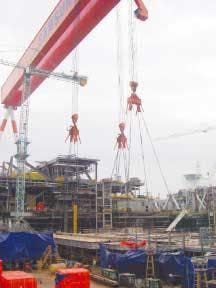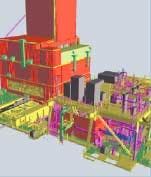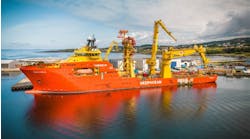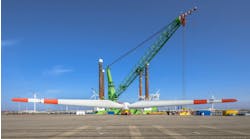Jeremy Beckman
Editor, Europe
Phase 2 of Sakhalin II is forging ahead. Construction of the Lunskoye-A plat-form is moving toward completion and the 21,000-tonne integrated deck is currently under construction on Geoge Island, South Korea. Fabricator Samsung Heavy Industries is also building the 24,948-tonne Piltun-B deck, and both topsides are scheduled for load out in 2006.
For Samsung and AMEC, the topsides design and engineering contractor, the schedule is tight, and the work-scope is unusually demanding. Both platforms must withstand potential assaults by earthquakes, strong waves, and ice. The precautionary strengthening, stabilization, and protective measures are setting new benchmarks in harsh environment engineering.
Sakhalin II Phase 2, with an estimated cost in excess of $10 billion, is the world's largest upstream and downstream oil and gas project. Phase 1, which cost a mere $1.5 billion, focused on oil from the Piltun-Astokhskoye field. Here, crude is produced six months a year through the Molikpaq (PA-A) platform, then piped a short distance to a single anchor leg mooring for subsequent pumping to the Okha FSO. Oil is offloaded to shuttle tankers, but only during the ice-free season. Operations are not possible during the winter months.
That should not be the case under Phase 2, with the two new drilling and production platforms. PA-B is designed to extract oil and gas from the northern part of the Piltun-Astokhskoye field, while LUN-A will produce mainly gas and condensate from Lunskoye. Both fields are in shallow water 15 km off the northeast coast of Sakhalin Island in the Sea of Okhotsk, with combined recoverable reserves of 1 Bbbl of oil and condensate and 18 tcf of gas.
New long-distance pipelines will be installed, mostly overland, transporting oil and gas from both the new installations and the Molikpaq to a processing facility on the island's southern tip, continuing to Aniva Bay, where an oil export terminal and an LNG plant are also under construction. The latter, due onstream in 2007, will feature two of the world's largest gas liquefaction process trains, with annual capacity of 4.8 million tonnes each.
Sakhalin Energy Investment Co. contracted London-based AMEC in 2001 to perform front-end engineering studies for the two platform decks. AMEC also secured the $230 million detailed design and engineering award in January 2003, with Samsung clinching the fabrication orders.
Platform plans
PA-B will be a production platform with full drilling capability, designed to handle up to 70,000 b/d of oil. Its integrated deck will measure 50 x 84.5 x 69.5 m. LUN-A will be a wellhead platform with primary separation capability, knocking out free water during separation and exporting gas and condensate to the shore in a multiphase wellstream. It will produce up to 1,800 MMcf/d of gas and 50,000 b/d of condensate via 30 wells. Top-sides dimensions are 40.5 x 82 x 40 m.
The Lunskoye-A UD50 topsides module (662 tonnes) is lifted into place.
null
Both will be mated to pre-installed concrete gravity bases currently under construction at a purpose-built casting basin in Vostochny Port, near Valdivostok. These are due to be completed next spring, then towed out to the field locations and installed by Aker Marine Contractors. LUN-A's substructure, weighing 151,000 tonnes, will be in a water depth of 48 m, and PA-B's in 30 m.
The decks will be floated over the substructure legs and fixed in place by Saipem using a giant barge. These loads will represent the largest topsides deliveries to date via the floatover method, beating Saipem's own record. According to AMEC's Sakhalin II project director Roger Swaine, the location and the environment dictated the huge scale of the platforms. Both will be self-contained drilling, production, utilities, and quarters installations, which must be able to operate year-round in a region where seas are icebound six to eight months of the year, with air temperatures dipping to -40° C. Self-sufficiency will be tested during particularly severe periods, when access by supply vessels may prove impossible.
Environmental concerns
The installations have been designed to resist a 200-yr strength level earthquake and a 3,000-yr ductility level earthquake. This represents an order of magnitude greater than anything attempted previously, Swaine says.
"Above all," Swaine adds, "the platforms need to be extremely robust to cater for the seismic design criteria." The last major earthquake to strike the island, at Neftegorsk in 1995, caused a lot damage and casualties. "Our platforms must withstand similar force," he says, "without loss of life or injuries to the crew, and all hydrocarbon systems, accommodation, and escape routes must remain intact. And repairs need to be enacted at the same time as bringing the facility back online."
The Malampaya platform in The Philipp-ines, which also sits on a gravity base, employs tubular isolators to counter seismic shocks. These would be impractical, however, on PA-B and LUN-A, due to the combination of stronger earthquakes in the Sakhalin region, and the much heavier topsides. Instead, AMEC opted for a seismic isolation system, hitherto untried offshore, known as Friction Pendulum bearings. These were a proprietary design of San Francisco-based Earthquake Protection Systems.
Friction Pendulum seismic isolation bearings are joints installed between the topsides and the substructure. On Sakhalin II, they will "isolate" the topsides from severe earthquake motions by employing the characteristics of a pendulum to lengthen the structure's natural period. When activated by a seismic shock, the convex bearing, or articulated slider, moves along the concave plate underneath, causing the topsides to move with small pendulum motions. In the event of a vertical movement, the top plate on which the topsides rest can twist, but the concave plate can also restore its own position and the topsides' equilibrium.
The dynamic friction force generated supplies sufficient damping to absorb the earthquake's energy. As a result, lateral loads and shaking movements transmitted to the topsides are greatly reduced. The bearings retain their properties over long periods of time, and when subjected to extremes of temperature, thanks to a self-lubricating composite material.
Reliability and consistency have been verified by leading earthquake test laboratories in the US. Adapting a solution for Sakhalin II, however, involved a 12-month program of finite element analysis and screening of different materials. The scale of this approach might have been lessened through use of steel for the Sakhalin II substructures. Concrete, unlike steel, is not ductile and does not deflect seismic shocks. This necessitated comprehensive strengthening of the topsides steelwork, in turn pushing up the overall weight.
Another feature of the environment off Sakhalin Island is unusual sea conditions. These include a wide spectrum of waves and tides, rapidly changing currents, and a continental shelf that tails off only gently from the beach. According to Swaine, this combination can lead to very significant wave heights during 100-yr wave conditions, much greater than in other parts of the world. "And on occasions, when the ice is melting, large blocks can be thrown against the deck or substructure, creating significant damage in just one pass," he says. To guard against such incidents, the air gap between deck and substructure on both platforms is 29 m, which compares with 19-22 m for a typical North Sea installation. That in turn impacts sea fastening and transportation to the offshore locations.
"At Samsung's yard, the underside of the decks is 20 m above floor level. They must be at least that height to ensure load-out of the structure onto the transportation barge," he says.
"We must therefore make sure that the topsides are commissioned as much as possible before taking them offshore," Swaine says. "The single-piece installation enables us to maximize completion onshore. But also, as this region is remote, there are limited crane barges available for an alternative modular approach, and in any case, the water depth, sea conditions, and climate are all totally unsuited to a modular installation. Logistically, that rules out conventional crane barges. Hence the need for an air gap that restricts hook height."
Calgary-based Tri-Ocean has performed all the drilling module design, under a risk-sharing arrangement. The Rubin Design Institute in St. Petersburg is responsible for detail design of the living quarters, both of which are being assembled by Samsung. Rubin, traditionally a submarine specialist, is also working on the Prirazlomonye platform substructure offshore northern Russia, and is looking to participate in studies for the Sakhalin V PSA, led by BP and Rosneft.
The Lunskoye-A platform schematic.
null
The PA-B and LUN-A living quarters are fairly conventional, according to Swaine. "But with such a wide range of air temperatures, from -40° C in winter to +32° in summer, the main challenge is the design of the heating, ventilation, and air conditioning plant. This must provide 3.5 MW of heating duty – partly provided by waste heat recovery from the gas turbine generators – and 0.8 MW of cooling duty. Those levels are extraordinary, at least twice as high as in conventional North Sea, Gulf of Mexico, or eastern Canada platforms."
An added problem in winter is wind chill, equivalent at times to -50° C. The minimum temperature in which the crew can operate at all effectively is thought to be -35° C, and then for only a maximum of 15 min. The solution on the two new platforms is a combination of extensive wind-walling, and temporary, inflatable heated habitats.
"These units are portable, and can therefore be moved around the platforms. This also reduced the maintenance burden on a permanent basis," Swaine says.
Mandatory requirements for Sakhalin II Phase 2 include re-injection of all produced water; re-injection of oil-based mud cuttings, with provision on the deck for also handling produced sand; no continuous flaring or venting; waste heat recovery to maximize energy efficiency; and most important, zero oil and chemical spills, even after a seismic event.
"We cannot afford any rupture that would lead to spillage," Swaine says. "This project has such a high profile. This means a more onerous approach to pipe stressing and adapting different loading parameters, which our suppliers must comply with in their package designs. The Russian approval bodies have also insisted that special filters be incorporated in the substructures. The filters are designed to prevent ingestion of young fish during the spawning season so that they don't get sucked into the seawater lift system."
Team work
Detailed design, equipment procurement, and the electrical and installation designs were all completed this summer. At peak, this was one of the world's largest offshore design and procurement contracts, involving 800 AMEC personnel at five locations in the UK, St. John's in Canada, and Moscow. They were also interfacing with the gravity base structure team led by Aker-Kværner in Oslo, the tanker loading unit team in The Netherlands, Saipem in Milan for the pipelines, and Parsons E&C in the UK for the onshore processing facility.
Samsung has also had to tackle some challenging fabrication issues, including adapting special welding procedures and materials to assemble the main deck frames. "These are a conventional plate girder design, but the low tensile steel employed is very heavy, which can lead to deposition of weld material in key members," Swaine says.
The problem lies in the fact that a large amount of pre-heat must be put into a large structure to offset the steel's low temperature, and that also requires a lot more post-welding verification.
AMEC has introduced various ISO, API, ANSI, and ASME standards, combining these with applicable Russian standards. In effect, the company has created hybrid project specifications that are acceptable to Russian regulatory bodies and that could be used elsewhere on other offshore projects, Swaine says.
Speaking at last year's Sakhalin conference in London, Swaine commented that foreign contractors working in the region needed more information on the capabilities of Russian suppliers and technical institutes; greater transparency on legal and regulatory issues; and a more realistic approach to execution strategies for multi-billion dollar projects.
"I have been in several discussions with investors such as BP and ConocoPhillips," he says, "which indicate there is a need to re-invent the way we execute large, complex projects in frontier areas. Extrapolating the usual management techniques that have been proven in the North Sea or Gulf of Mexico is just not good enough."





